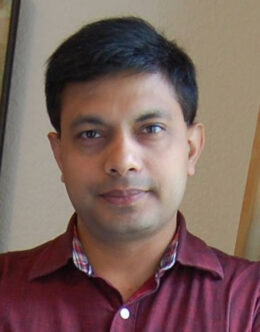Signal Processing for Joint Radar-Communications
: In this talk, we focus on the recent developments toward integrated sensing and
communications (ISAC). We consider a broad definition of coexistence, which covers ISAC,
collaborative communications, and sensing with interference. Toward fully realizing the
coexistence of the two systems, optimization of resources for both new/futuristic sensing and
wireless communications modalities is crucial. These synergistic approaches that exploit the
interplay between state sensing and communications are both driving factors and opportunities
for many current signal processing and information-theoretic techniques. In addition, a large
body of prior works considers colocated ISAC systems while distributed systems remain relatively
unexamined. Building on the existing approaches, the tutorial focuses on highlighting emerging
scenarios in collaborative and distributed ISAC, particularly at mm-Wave and THz frequencies,
highly dynamic vehicular/automotive environments that would benefit from information
exchange between the two systems. It presents the architectures and possible methodologies
for mutually beneficial distributed co-existence and co-design, including sensor fusion and
heterogeneously distributed radar and communications. The tutorial also considers recent
developments such as the deployment of intelligent reflecting surfaces (IRS) in ISAC, 5G systems,
passive internet-of-things, and ISAC secrecy rate optimization. This tutorial aims to draw the
attention of the radar, communications, and signal processing communities toward an emerging
area, which can benefit from the cross-fertilization of ideas in distributed systems.
Date and Time
Location
Hosts
Registration
Speakers
 Kumar Vijay Mishra
Kumar Vijay Mishra
Signal Processing for Joint Radar-Communications
In this talk, we focus on the recent developments toward integrated sensing and
communications (ISAC). We consider a broad definition of coexistence, which covers ISAC,
collaborative communications, and sensing with interference. Toward fully realizing the
coexistence of the two systems, optimization of resources for both new/futuristic sensing and
wireless communications modalities is crucial. These synergistic approaches that exploit the
interplay between state sensing and communications are both driving factors and opportunities
for many current signal processing and information-theoretic techniques. In addition, a large
body of prior works considers colocated ISAC systems while distributed systems remain relatively
unexamined. Building on the existing approaches, the tutorial focuses on highlighting emerging
scenarios in collaborative and distributed ISAC, particularly at mm-Wave and THz frequencies,
highly dynamic vehicular/automotive environments that would benefit from information
exchange between the two systems. It presents the architectures and possible methodologies
for mutually beneficial distributed co-existence and co-design, including sensor fusion and
heterogeneously distributed radar and communications. The tutorial also considers recent
developments such as the deployment of intelligent reflecting surfaces (IRS) in ISAC, 5G systems,
passive internet-of-things, and ISAC secrecy rate optimization. This tutorial aims to draw the
attention of the radar, communications, and signal processing communities toward an emerging
area, which can benefit from the cross-fertilization of ideas in distributed systems.
Biography:
Kumar Vijay Mishra (S’08-M’15-SM’18) obtained a Ph.D. in electrical engineering and M.S. in
mathematics from The University of Iowa in 2015, and M.S. in electrical engineering from
Colorado State University in 2012, while working on NASA’s Global Precipitation Mission Ground
Validation (GPM-GV) weather radars. He received his B. Tech. summa cum laude (Gold Medal,
Honors) in electronics and communication engineering from the National Institute of Technology,
Hamirpur (NITH), India in 2003. He is currently Senior Fellow at the United States Army Research
Laboratory (ARL), Adelphi; Technical Adviser to Singapore-based automotive radar start-up
Hertzwell and Boston-based imaging radar startup Aura Intelligent Systems; and honorary
Research Fellow at SnT - Interdisciplinary Centre for Security, Reliability and Trust, University of
Luxembourg. Previously, he had research appointments at Electronics and Radar Development
Establishment (LRDE), Defence Research and Development Organisation (DRDO) Bengaluru; IIHR
- Hydroscience & Engineering, Iowa City, IA; Mitsubishi Electric Research Labs, Cambridge, MA;
Qualcomm, San Jose; and Technion - Israel Institute of Technology.
Dr. Mishra is the Distinguished Lecturer of the IEEE Communications Society (2023-2024), IEEE
Aerospace and Electronic Systems Society (AESS) (2023-2024), IEEE Vehicular Technology Society
(2023-2024), IEEE Geoscience and Remote Sensing Society (2024-2025), and IEEE Future
Networks Initiative (2022). He is the recipient of the IET Premium Best Paper Prize (2021), U. S.
National Academies Harry Diamond Distinguished Fellowship (2018-2021), American
Geophysical Union Editors' Citation for Excellence (2019), Royal Meteorological Society Quarterly
Journal Editor's Prize (2017), Viterbi Postdoctoral Fellowship (2015, 2016), Lady Davis
Postdoctoral Fellowship (2017), DRDO LRDE Scientist of the Year Award (2006), NITH Director’s
Gold Medal (2003), and NITH Best Student Award (2003). He has received Best Paper Awards at
IEEE MLSP 2019 and IEEE ACES Symposium 2019.
Dr. Mishra is Chair (2023-present) of the Synthetic Apertures Technical Working Group of the
IEEE Signal Processing Society (SPS) and Vice-Chair (2021-present) of the IEEE Synthetic Aperture
Standards Committee, which is the first SPS standards committee. He is the Chair (2023-2026) of
the International Union of Radio Science (URSI) Commission C. He has been an elected member
of three technical committees of IEEE SPS: SPCOM, SAM, and ASPS, and IEEE AESS Radar Systems
Panel. Since 2020, he has been Associate Editor of IEEE Transactions on Aerospace and Electronic
Systems, where he was awarded Outstanding Editor recognition in 2021. He has been a
lead/guest editor of several special issues in journals such as IEEE Signal Processing Magazine,
IEEE Journal of Selected Topics in Signal Processing, and IEEE Journal on Selected Areas in
Communications. He is the lead co-editor of three upcoming books on radar: Signal Processing
for Joint Radar-Communications (Wiley-IEEE Press), Next-Generation Cognitive Radar
Systems (IET Press Radar, Electromagnetics & Signal Processing Technologies Series),
and Advances in Weather Radar Volumes 1, 2 & 3 (IET Press Radar, Electromagnetics & Signal
Processing Technologies Series). His research interests include radar systems, signal processing,
remote sensing, and electromagnetics.
Address:US Army Research Labs, , Adlephi, United States


 Add Event to Calendar
Add Event to Calendar